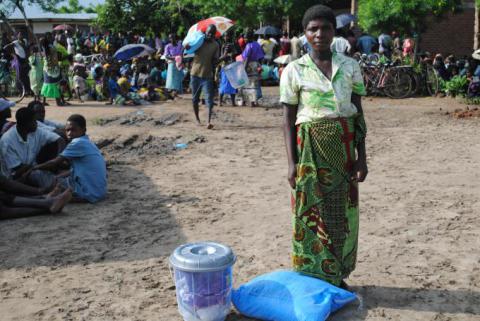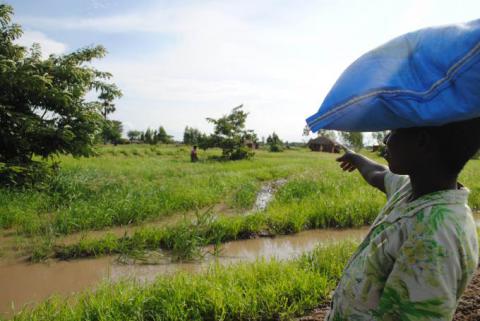Malawi Floods – Shelter Concerns Amidst Displacement
From the onset, it appeared to be a somber day as we approached the village of Kathebwe, in Traditional Authority (TA) Mwambo, Zomba District. The sky was covered in a blanket of uniform clouds that occasionally gave the sun some shine. Out in the distance were fields of crops laid with isolated beds of water – some even forming streams and interconnected water systems. In the trenches, between rows of crops were still waters that resembled an irrigation scheme, but were really remnants of the flowing waters that had recently washed crops away. People went about their day-to-day activities, some attending to their crops, some travelling to-and-fro on the main dirt road and others sitting on the verandas of their homes--those that were still in-tact.
For some people however, they were not fortunate enough to have their homes spared by the devastating floods that recently swept over half of the country’s 28 districts. At Chinkhwangwa Primary School, Save the Children’s humanitarian team on Wednesday 4th February distributed food and other essential items that consisted of buckets, plastic plates and cups, mosquito nets, maize and phala to 1108 households affected by the floods. The school ground was filled with people who sat where they could – some under shade, others out on the open ground, getting an occasional scorching from the sun that frequently found its way through the moving clouds.

And so they sat, either waiting to hear their names on the distribution list – or remaining seated even after being called because they had no where else to go. This is the case for most people in the area and is a reflection of what’s happening across Malawi’s affected districts. According to UNICEF’s most recent situational report, 360,000 people have been displaced as a result of these floods – some in camps and a majority being hosted within communities, which include 181 schools across the country being used as temporary shelters.
For Chinkhwangwa Primary School and similarly in many others, during school hours, it is filled with students – but as soon as the students leave, people fill the school classrooms – the old, the young, boys and girls – hundreds in numbers, seeking refuge for the night. Schools are serving as a safe haven for many people who would otherwise be walking around idly, taking shelter in random places or attending to what is left of their crops during the day.

We managed to hear from Asiyireni Kamaliza, a mother who had just collected her items and was on her way to check on her home. She used to reside a short distance from the distribution point until her house was destroyed by the rains and now takes shelter with her family at the school. Along the walk to her home, she left some of her newly acquired belongings at a friend’s place and then took us to what from a distance looked like a freestanding structure with a lopsided thatched roof. Upon closer inspection, you could see that two of the house’ facing walls had been badly worn down by the flooding – forcing a majority of the home’s thatched roof to cave in. “I feared for my life as the water quickly rushed into our home. My husband and I first put our children to safety and then began collecting as many items as we could,” she recalled.
Unfortunately, they could not manage to save all of their belongings. “The items we are getting from Save the Children are helping us because almost all our belongings have been washed away or got destroyed,” she said. All the family has remaining is roughly a quarter of their crops, mainly maize and pigeon peas. A lot of families have begun replanting in an effort to recover from the loss. Roughly 116,000 households have lost their crops and livestock, according to the Department of Disaster Management Affairs (DoDMA) and the United Nations Resident Coordinator’s Office’ (UNRCO) most recent situation report. In response, the national level cluster has thus far provided 1,700 Metric Tonnes of food assistance. It is estimated that a total of 26,000 Metric Tonnes of food assistance is required in the affected areas.
Save the Children has distributed 177 Metric Tonnes of food commodities to vulnerable households in its flood response focal districts of Zomba, Chiradzulu, Phalombe, Chikwawa and Nsanje. Save the Children has to date also distributed cash to 8,584 households in Machinga, Zomba, Nsanje and Mulanje under its Cash Transfer Programme (CTP). Although it is separate initiative from the flood response, the CTP is scheduled to last until April and will serve as a much-needed supplementary form of support for many people in the same affected districts who are yet to experience the end of the floods.
Malawi is a country that experiences natural disasters on a yearly basis commonly in the form of flash floods and droughts, but this most recent flood is the worst case of flooding to hit the country since 1964. The rainy season lasts until April – peaking usually in mid February. With the soil currently being as saturated as it is and with people only just recovering, the impact of very probable heavy rainfall that is yet to come could be disastrous.
Although the response has picked up from the districts up to the national level, there have been mutual sentiments from various stakeholders on the tardiness and incoordination of the overall response. Granted, as a nation, we were taken unawares by what was one of the worst flood disasters to impact Malawi in recent times – but we will need to continue to respond with urgency for Malawi’s 1.5 million impacted people who will feel the effects of these floods for months, if not years to come. Having learnt from this sudden experience, moving onwards – it will be up to the continued and concerted efforts of the Government, the UN and NGOs as well as support from the international aid community that will determine how we minimize the impact on Malawi’s affected population.
Written by Luzayo Nyirongo, Strategic Communications Officer
 Malawi
Malawi